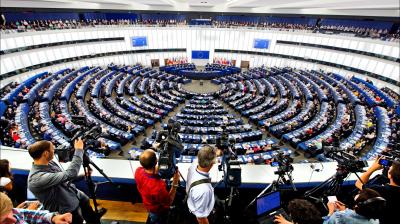European Parliament elections have never been more uncertain. In Italy, some important electoral alliances still need to be sealed: Salvini’s Lega[i] will most certainly remain in the Europe of Nations and Freedom (ENF) group - although he is weaving larger alliances with representatives of nationalist parties from Visegrad countries and trying to lure Orban’s Fidesz away from the European People Party (EPP). Also Di Maio’s Five Star Movement (M5S), currently in the Europe of Freedom and Direct Democracy (EFDD), is trying to create a new group with Polish, Croatian, Finnish and Greek parties, but is still 2 parties short. The main opposition parties will remain within their current groups: The social democratic party Partito Democratico (PD) and other parties on the left (with a sprinkling of independents joining the Greens) will stay within the Socialists and Democrats (S&D) group. And Forza Italia will stay within the Christian Democratic Group of the European People’s Party (EPP). Strategizing about European-level alliances is therefore most intense among the governing parties. Their European and domestic strategies feed upon each other. At home, the increasingly troubled relationship between the two coalition parties is mostly due to the power struggle that they are engaged in: While they incessantly repeat the promise that their government will last the entire legislature, they meanwhile maneuver so as to kill it at the most opportune moment (in terms of prospective votes for their own party at either the European or national elections). Their hanging together is therefore mostly due to the calculation that the European elections might bring a veritable political sea-change.
"Domestically, it is now commonplace to observe that these two parties disagree on just about any policy issue."
Domestically, it is now commonplace to observe that these two parties disagree on just about any policy issue, and that the only reason they have managed to govern together so far is that they underwrote a coalition agreement which simply added the pet policies of one to the pet policies of the other, without much concern for the total sum of public resources that it would require to be implemented. We have witnessed in the fall of 2018 the tug-of-war between this government and the Commission over the size of the Italian public deficit in 2019. There appeared to be no identifiable macroeconomic strategy behind the proposed measures other than the hope of relaunching the Italian economy through an injection of public funds for the ailing strata of the population and of confidence-boosting national jingoism – a Keynesian strategy of sorts, expected to work mainly by reversing the pessimistic mood that has gripped the country since the crisis. By doling out some state aid to the unemployed and the poor, by soothing the trauma of a perhaps too drastic and too swift pension reform, and by promising the introduction of a simplified tax code (a still unspecified “flat-tax” regime whose appeal lies more in its promise to simplify the overly complex Italian tax code than in its real consumption and investment boosting effect), the governing parties hoped to reverse the expectations of the Italian public and Italy would resume growth. It is clear that both parties have staked the efficacy of this “economic program” on the hope that the political complexion of the EU after the European elections – which they expect will yield a massive win for the populist, nationalist and sovereignist parties – would validate ex-post their ex-ante hazardous bet.
"It is difficult to subscribe to the narrative that this government has a clear social vision and is able to pursue a well-defined growth strategy for Italy."
Also prospectively, however, the governing parties subscribe to very different economic and social visions. When it comes to balancing environmental and productive concerns, the M5S wants to halt most infrastructural and productive investment, while the Lega wants to move forward. On security and immigration issues the Lega pursues an uncompromising migrant-rejection policy, while the M5S displays a much more open attitude. On energy provision the Lega is siding with those EU member states determined to keep using their coal reserves, while the M5S wants to introduce a tax on carbon emissions and a tax break for eco-friendly vehicles. On broad moral issues as well as on public health issues the M5S is more permissive, while the Lega is more conservative. The M5S is in favor of extensive state intervention in the economy, while the Lega supports large and small entrepreneurs’ claims for greater freedom of maneuver. The list of differences between the governing parties could go on and on. Hence it is difficult to subscribe to the narrative that this government has a clear social vision and is able to pursue a well-defined growth strategy for Italy and, what’s more, that it will last the length of the legislative period. Neither can international observers and operators be blamed for not trusting the solidity, credibility and determination of this government to address some of its major problems - in particular the sustainability of the Italian public debt.
True, markets’ assessments are not necessarily “objective” and fair. Inter-temporal and cross-sectional comparisons[ii] reveal that the same debt/Gross Domestic Product (GDP) ratios are assessed in sometimes very different manners and that they may not fully take into account other important elements (the so-called fundamentals). These assessments then have very real repercussions on the premiums that must be paid on national sovereigns and tend to fulfill the expectations that caused them. Credit-rating agencies, moreover, tend to follow and validate these wide-spread expectations.[iii] At EU-level, conversations are being held about debt-restructuring provisions that would kick in when member states overstep certain thresholds of debt/GDP ratios. Needless to say, within these circles in Brussels, they principally think about the Italian debt. For many reasons, being forced to restructure would certify the inability of the Italian state to manage its own finances and would bring about real hardship for those Italians – just about everyone – who have invested part of their savings in Italian treasury bonds. By now it appears very difficult for a country like Italy that incurs the negative assessment of the markets and credit agencies to climb back up - particularly when governmental action is hesitant, patched-up or, worse, leads to the further worsening of the economic outlook. For these reasons, winning and maintaining a credible reputation is of the essence.
Moreover, there is a risk that the outcome of the forthcoming EU budget negotiations will reduce, or at best maintain, the resources for cohesion policy. Even more prevalent is the risk that resources might be redirected from investment aid and employment support towards assisting those structural reforms that may further destabilize the situation of Italian workers - who are not yet fully protected by welfare measures that are taken for granted elsewhere in Europe. On the other hand, both governing parties have a positive view of Juncker’s ongoing investment initiative of 2014, which is a somewhat circuitous way of partially meeting a long-standing Italian demand from both the left and right, voiced among others by Prime Minister Mario Monti in 2012, to exclude public investment spending from the Stability and Growth Pact (SGP) limits. To what extent the plan will be able to compensate for the expected negative impact of the reorientation of cohesion policy remains to be seen, however.
"International markets have little time and patience for the continuous repositioning of Italian governing parties and their single-minded jockeying for popular support"
It is precisely at the international level that the political strategizing of the two governing parties - which Italians domestically are so used to and so adept at deciphering - becomes potentially explosive. International markets have little time and patience for the continuous repositioning of Italian governing parties and their single-minded jockeying for popular support, and tend to assess Italy’s prospects excessively harsh. After all, Italy is a major exporting economy with positive current accounts, it has recorded primary surpluses virtually uninterruptedly since the early 1990s and belongs to the major league of the world’s manufacturing countries. The negative international assessment, therefore, tends to fan Italians’ resentment and may trigger ugly attempts at restating the national pride. The underlying “love affair” of Italians with the European project – which promised to make everything right that Italians had not succeeded in doing since Unification, but would at the same time preserve the “Italian way of life”[iv] – is at risk of turning into an embittered relationship so typical of partners who fall out of love with each other.
[i] Previously known as “Lega Nord”, since 2016 the party has been rebranded as “Lega”, as Salvini enacted a strategy of appealing to the conservative vote throughout Italy. Yet, for the moment, this party still officially appears as "Lega Nord" in the European Parliament.
[ii] Inter-temporal comparisons describe the debt situation of the same country between different points in time. Cross-sectional comparisons include different countries at the same point in time.
[iii] Codogno, Lorenzo, “Ratings: Core is from Mars, periphery is from Venus”, European Economic Notebook, 29.04.2019.
[iv] The “Italian way of life” must be understood as a mix of bonhomie and commitment rather than as “la dolce vita”, as is often mistakenly believed.






